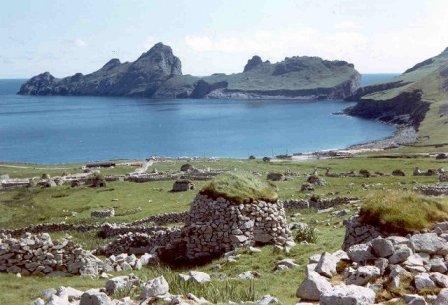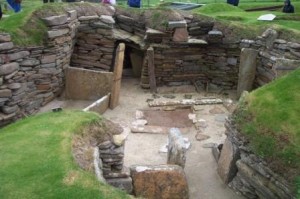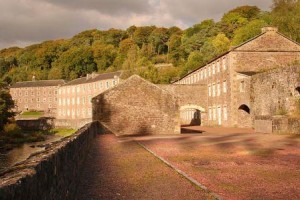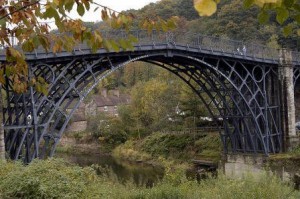
Village Bay, St Kilda - © Ian Mitchell
The volcanic archipelago of St Kilda is an established World Heritage Site having been included in the list since 1986. The group of islands are located to the west of the Outer Hebrides in Scotland, making them the most remote of Scotland's World Heritage Sites. Whilst the islands were previously populated since 1930 when the population were evacuated, they have been uninhabited apart from military personnel. The islands are of great importance for wildlife and home to some rare and endangered species.
Overview
St Kilda is a volcanic archipelago, the islands offer some stunning landscapes and scenery. They are located off the coast of the Outer Hebrides in one of the most remote areas of the UK. There are four islands here namely Boreray, Dun, Hirta and Soay and home to some of the largest cliffs in Europe. The islands are one of the few sites on the WHO list that are recognised for both their natural and cultural significance and are among the most important seabird colonies and a major seabird breeding station in the North Atlantic.
The archipelago offers evidence to over 2,000 years of human occupancy in the harsh climate and conditions that are prevalent here in the Hebrides. The islands were evacuated in 1930 and there has been no permanent human occupation here since apart from military personnel.
The islands are regarded as among the finest places in the UK for diving owning to the clear local water, caves and arches. On the Island of Boreray there is the world’s largest colony of gannet’s nests and the islands combine to contain the largest colony of fulmars in the UK. The islands contain some extensive remains of vernacular buildings, these include the remains of a 19th century village and a number of stone built cleitean (stone storage buildings) that are located all across the islands. Seabirds used to form a major part of the local diet, these included fulmars and puffins, the locals used to eat seabirds as a snack too.
The original WHS put in place in 1986 was further extended in 2004 to include a larger area to take in to account the surrounding marine features. The total WHS now covers over 93 square miles, that includes areas on both land and sea.
There has been work carried out to help ensure the protection and preservation of the islands, the islands gained a higher profile and worldwide recognition since being added to the WHS list. There are however a number of potential treats to the preservation of the islands these include Natural Threats
The National Trust for Scotland is responsible for ensuring the preservation of the islands including the cultural, landscape and natural heritage. Among the potential human treats to the islands are boats unwittingly bringing animals on the island that can destroy or threaten the established ground-nesting birds here.
The seabirds which the islands are famous for feed in the waters around the islands, however there are potential hazards at sea with possible radioactive substances, oil spillages and other hazards presenting a potential problem.
The buildings, landscape and wildlife of the area are protected by a number of designations, apart from the WHO status the area is also a European Union Special Protection Area relating to the European Union directive on the Conservation of Wild Birds. The trust along with other relevant authorities aims to ensure the islands are preserved and conserved for future generations to appreciate.
For visitors to the area, there is the opportunity to see the raw power of nature, amazing scenery and a wealth of wildlife. For those visitors wishing to see something off the beaten track and go somewhere few others have been the islands presents an opportunity to see one of the world's acclaimed culture and natural sites.
How To Get There
For visitors wishing to see the islands the journey is not as straight forward as is the case with many other places in the UK. However for those visitors that are determined and persistent there are ways visitors can access the islands, these include:
By Charter boats:
Charter boats operate from various ports such as Oban. For further details of the precise times of the boats and the prices, travellers should contact the companies directly. Visitors should be aware of the journey times that can vary from approx 8 hours from the Western Isles to close to 15 hours from Oban. Please see Charter Boat Operators for more information
By Cruise ship:
There are a number of large cruise ships that offer visitors the chance to see the islands each year. There is a cruise from the National Trust for Scotland Cruise. The itineraries are liable to alter each year, therefore it is wise to check online to the latest dates. Please see National Trust for Scotland Cruise for more information
By Yachts:
Visitors can travel to the islands by private yacht or boat. If visitors use private boat or yacht if is necessary to inform the National Trust of Scotland with your travel plans including the timings for your arrival and departure. The contact details for the trust are:
National Trust for Scotland
Balnain House
40 Huntly Street
Inverness
IV3 5HR
Tel: +44 (0)1463 232 034
Visitors should also note that they need to contact the ranger on arrival and given there is limited accommodation, booking is essential before starting your trip. It is highly recommended visitors contact the Trust and check all the correct travel protocols and requirements and adhere to these when travelling.
Contact Details
Address:
National Trust for Scotland
Holidays Department
Wemyss House
28 Charlotte Square
Edinburgh
Telephone: +44 (0)131 243 9334
Website: St Kilda
Facilities and Information
Facilities:
There is limited accommodation available for visitors and all travel plans should be checked and booked well in advance. For those that like creature comforts and luxury whilst travelling, a trip here is unlikely to appeal. Whilst those with a spirit of adventure, who are happy to forgo luxury when visiting, are likely to find a visit here appealing.
Visitors should bear in mind a trip here offers a different type of trip to a naturally beautiful but remote part of the UK.
When visiting the area it is recommended visitors contact the National Trust of Scotland for help and advice on their trips including travel tips and precautions that should be taken. Also the travel itineraries and times of arrival and departure should be left with the trust also as a safety step when travelling to a remote and isolated area.
Map
View Larger Map
Tips & Other Considerations
Given the remote location of the islands those wishing to visit the area need to determined, there is no easy straight journey to the islands however it is possible for those that are determined.
The location means the islands are often at the mercy of nature and the local weather that can be extreme meaning timings of trips to the islands can be postponed or cancelled at short notice.
The islands may appeal to those who wish to see something a bit different, those with a spirit of adventure and those that wish to experience something out of the ordinary on a tourist break.
Travellers to the region should ensure they are well prepared and know what to expect. The conditions and weather can be harsh, ensure you have the correct clothing and any equipment you may require.
Despite the journey to the islands not being as straight forward as most visitor destinations, the stunning scenery, spectacular natural environment and surroundings make it worthwhile and offer visitors the chance to see a place that is extraordinary in many ways.
Disclaimer: The information given in on this website is given in good faith and to the best of our knowledge. If there are any discrepancies in no way do we intend to mislead. Important travel details and arrangements should be confirmed and verified with the relevant authorities.




